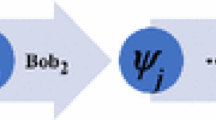Abstract
The main weakness of entanglement is its sensitiveness to the photon loss. In this paper, we exploit the different transmission losses of the free-space and optical fiber quantum channels, to develop a novel approach for (2,3) threshold quantum secret sharing (QSS) of classical information. To be exact, the Dealer Alice allocates W-state to three participants Bob, Charlie and David in terms of the asymmetric losses of their quantum channels, preventing any one participant from recovering the secret alone, but allowing any two of them to recover the secret. In such a way, Alice can flexibly choose the suitable degree of freedom to allocate the quantum shares with respect to the loss characteristics of different quantum channels. Our proposed scheme improves the information capacity from three bits to \((\log _{2} m+2)\) bits, where m denotes the dimension of orbital angular momentum, and improves the security and flexibility of quantum communication, confirming QSS as a realistic technology for safeguarding secret shares in transmission. This work opens a convenient and favorable way to perform QSS.


Similar content being viewed by others
References
Hillery, M., Bužek, V., Berthiaume, A.: Quantum secret sharing. Phys. Rev. A 59, 1829–1834 (1999)
Greenberger, D.M., Horne, M.A., Zeilinger, A.: In: Kafatos, M. (ed.) Bell’s Theorem, Quantum Theory, and Conceptions of the Universe, pp. 73-76. Kluwer, Dordrecht (1989)
Fortescue, B., Gour, G.: Reducing the quantum communication cost of quantum secret sharing. IEEE Trans. Inf. Theory 58(10), 6659–6666 (2012)
Ahmadi, M., Wu, Y.D., Sanders, B.C.: Relativistic (2,3)-threshold quantum secret sharing. Phys. Rev. D 96(6), 065018 (2017)
Lance, A.M., Symul, T., Bowen, W.P., Tyc, T., Sanders, B.C., Lam, P.K.: Continuous variable (2,3) threshold quantum secret sharing schemes. New J. Phys. 5(1), 4 (2003)
Lai, H., Orgun, M.A., Xiao, J.H., Xue, L.Y., Pieprzyk, J.: Dynamic (2,3) Threshold quantum secret sharing of secure direct communication. Commun. Theor. Phys. 63, 459–465 (2015)
Zhou, Y.Y., Yu, J., Yan, Z.H., Jia, X.J., Zhang, J., Xie, C.D., Peng, K.C.: Quantum secret sharing among four players using multipartite bound entanglement of an optical field. Phys. Rev. Lett. 121(15), 150502 (2018)
Lai, H., Luo, M.X., Pieprzyk, J., Tao, L., Liu, Z.M., Orgun, M.A.: Large-capacity three-party quantum digital secret sharing using three particular matrices coding. Commun. Theor. Phys. 66(5), 501 (2016)
Gaertner, S., Kurtsiefer, C., Bourennane, M., Weinfurter, H.: Experimental demonstration of four-party quantum secret sharing. Phys. Rev. Lett. 98, 020503 (2007)
Lu, H., Zhang, Z., Chen, L.K., Li, Z.D., Liu, C., Li, L., Liu, N.L., Ma, X., Chen, Y.A., Pan, J.W.: Secret sharing of a quantum state. Phys. Rev. Lett. 117(3), 030501 (2016)
Dür, W., Vidal, G., Cirac, J.I.: Three qubits can be entangled in two inequivalent ways. Phys. Rev. A 62(6), 062314 (2000)
Yamamoto, T., Tamaki, K., Koashi, M., Imoto, N.: Polarization-entangled W state using parametric down-conversion. Phys. Rev. A 66, 064301 (2002)
Eibl, M., Kiesel, N., Bourennane, M., Kurtsiefer, C., Weinfurter, H.: Experimental realization of a three-qubit entangled W state. Phys. Rev. Lett. 92, 077901 (2004)
Gorbachev, V.N., Trubilko, A.I.: On multiparticle W states, their implementations and application in the quantum informational problems. Laser Phys. Lett. 3, 59–70 (2006)
Fan, R.H., Guo, B.H., Guo, J.J., Zhang, C.X., Zhang, W.J., Du, G.: Entangled W state of multi degree of freedom system based on orbital angular momentum. Acta Phys. Sin. 64(14), 140301 (2015)
Chen, L., She, W.: Spin-orbit-path hybrid Greenberger–Horne–Zeilinger entanglement and open-destination teleportation with multiple degrees of freedom. Phys. Rev. A 83(3), 032305 (2011)
Gräfe, M., Heilmann, R., Perez-Leija, A., Keil, R., Dreisow, F., Heinrich, M., Moya-Cessa, H., Nolte, S., Christodoulides, D.N., Szameit, A.: On-chip generation of high-order single-photon W-states. Nat. Photon. 8(10), 791 (2014)
Mikami, H., Li, Y., Kobayashi, T.: Generation of the four-photon W state and other multiphoton entangled states using parametric down-conversion. Phys. Rev. A 70(5), 052308 (2004)
Tashima, T., Kitano, T., Ozdemir, K., Yamamoto, T., Koashi, M., Imoto, N.: Demonstration of local expansion toward large-scale entangled webs. Phys. Rev. Lett 105(21), 210503 (2010)
Wang, X.L., Luo, Y.H., Huang, H.L., Chen, M.C., Su, Z.E., Liu, C., Zhang, J.: 18-qubit entanglement with six photons’ three degrees of freedom. Phys. Rev. Lett. 120(26), 260502 (2018)
Chen, X.Y.: Determining separability with entanglement of formation and entanglement sudden death. Chin. Phys. Lett. 32(1), 010301 (2015)
Semenov, A.A., Vogel, W.: Entanglement transfer through the turbulent atmosphere. Phys. Rev. A 81(2), 023835 (2010)
Yang, Y., Xu, L.P., Yan, B., Zhang, H.Y., Shen, Y.H.: Performance optimization for quantum key distribution in lossy channel using entangled photons. Chin. Phys. B 26(11), 110305 (2017)
Bohmann, M., Semenov, A.A., Sperling, J., Vogel, W.: Gaussian entanglement in the turbulent atmosphere. Phys. Rev. A 94(1), 010302 (2016)
Aolita, L., Walborn, S.P.: Quantum communication without alignment using multiple-qubit single-photon states. Phys. Rev. Lett. 98(10), 100501 (2007)
Paterson, C.: Atmospheric turbulence and orbital angular momentum of single photons for optical communication. Phys. Rev. Lett. 94(15), 153901 (2005)
Hwang, W.Y.: Quantum key distribution with high loss: toward global secure communication. Phys. Rev. Lett. 91, 057901 (2003)
Bennett, C. H., Brassard, G.: Quantum cryptography: public-key distribution and coin tossing. In: Proceedings of IEEE International Conference on Computers, Systems and Signal Processing (Bangalore, India), pp 175–179. IEEE, New York (1984)
Acknowledgements
Hong Lai has been supported by the National Natural Science Foundation of China (No. 61702427) and the Fundamental Research Funds for the Central Universities (XDJK2020B027), the Southwest University Research Fund (SWU1908043) the Chongqing innovation project (No. cx2018076). Ming-Xing Luo is supported by the National Natural Science Foundation of China (No. 61772437), Sichuan Youth Science & Technique Foundation (No. 2017JQ0048) and Fundamental Research Funds for the Central Universities (No. 2018GF07). Josef Pieprzyk has been supported by the Australian Research Council Grant DP180102199.
Author information
Authors and Affiliations
Corresponding author
Additional information
Publisher's Note
Springer Nature remains neutral with regard to jurisdictional claims in published maps and institutional affiliations.
Rights and permissions
About this article
Cite this article
Lai, H., Pieprzyk, J., Luo, MX. et al. High-capacity (2,3) threshold quantum secret sharing based on asymmetric quantum lossy channels. Quantum Inf Process 19, 157 (2020). https://doi.org/10.1007/s11128-020-02647-z
Received:
Accepted:
Published:
DOI: https://doi.org/10.1007/s11128-020-02647-z



